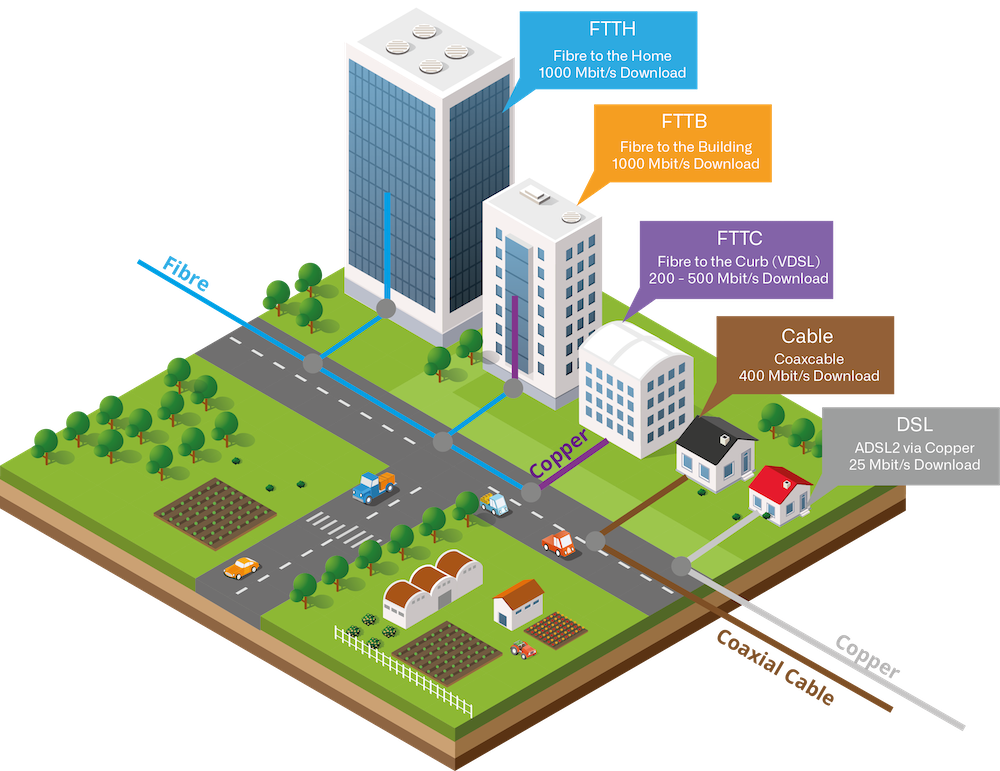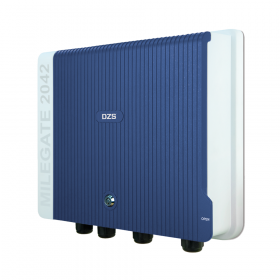G.fast technology accelerates traditional copper cables up to high bandwidths of almost 2 GBit/s. Our partner DZS has launched the new MileGate-205x series Distribution Point Units (DPUs) with Reverse Power Feed for this very purpose. These enable high-speed internet in apartment blocks where the fibre-optic cables are only laid as far as the cellar (Fibre To The Building, FTTB).
Due to the corona crisis, video conferences and working from home have become part of everyday life for many companies. But not all employees have a connection with sufficient bandwidth at home. Video conferences, streaming and other (business) applications from the cloud require fast, high-performance internet connections. The best solution for the broadband network are optical lines with fibre-optic cables. But the rollout of the high-speed fibre-optic network is taking a long time.
Generally, network operators use different combinations of copper cables and fibre optics. The bandwidth depends upon how far the fibre optic cable is from the end customer. Variants are Fibre To The Curb (FTTC), Fibre To The Building (FTTB) or Fibre To The Home (FTTH). The closer the fibre-optic cable is to your home, the higher the data rate.

In apartment blocks, the fibre-optic cables are primarily laid as far as the building’s cellar (FTTB). From there, it usually proceeds via copper cables within the building to the end customers’ connections in the individual apartments (= local loop or “last mile”). The high-speed G.fast technology accelerates this “last mile” to bandwidths of 500 MBit/s to 2 GBit/s. G.fast has been standardised by the ITU (International Telecommunication Union) (ITU-T G.9701) and stands for “Fast Access to Subscriber Terminals”. You can find a description of this technology in this blog article.
MileGate-205x series: a turbo boost for copper cables in apartment blocks
Our partner DZS has designed its G.fast-DPUs (Distribution Point Units) especially for FTTB (Fibre To The Building) installations and use in apartment blocks. This enables transmission rates similar to those of fibre-optic cables to be achieved using copper cables. The latest DPUs from the MileGate-205x series support G.fast with the profiles 212a and 106a. The G.fast 212a profile enables total data rates (downstream and upstream) of almost 2 Gbit/s to be achieved over short distances using existing copper cables.
With the MileGate-205x series, network operators can configure the ratio of downstream and upstream per port and subscriber, so that they are also able to provide symmetrical transmission rates. Users of the cloud, corporate customers and remote workers need this configuration. As well as G.fast, the DPUs also support VDSL2 fallback. This means network operators can extend the broadband technologies they offer in line with demand. Connection to the fibre-optic network is achieved via SFP+ modules with a 10 GbE or 1 GbE interface, or alternatively via GPON or XGS-PON. This ensures that it is possible to adapt to the particular network situation at any time.

The new DPUs are available in three variants:
- MileGate 2051: with four ports for small apartment blocks
- MileGate 2052: with eight ports
- MileGate 2053: with 16 ports for use in large apartment blocks or commercially-used buildings
Power supply via Reverse Power Feed
All DPUs from the new MileGate 205x series have Reverse Power Feed (RPF) technology, where the power is supplied by reverse feed from the connected subscriber. This is a big advantage, because this makes installation possible at locations where no power supply is available. A combination of both options simultaneously – connection via the 115/230V network and RPF – is also supported. Network operators can use this to introduce Gigabit services into apartment blocks more quickly, because they can circumvent the problem of power supply.
Some background: currently, DPUs generally get their power supply locally from the house network. This means that all occupants bear the electricity costs together – no matter whether they use the high-speed internet and its high bandwidth or not. Alternatively, the network operators must connect separate meters to determine the subscribers’ exact power consumption. In contrast, Reverse Power Feed enables the DPU to receive its power supply exclusively via the connected subscriber, without needing to install additional meters or a new local power supply. This saves costs and avoids complications which may arise when getting the required permissions for this kind of electricity connection from the house owners and the local authorities.
Metallic Line Testing for remote connection
Another important function of the new DPUs is Metallic Line Testing (MELT). This enables network operators to qualify the connection cable, determine external voltages, resistances and capacities during operation and, in case of a fault, to identify the type of interference source – all from their headquarters. A site visit is no longer necessary.
The MELT function is integrated in a circuit board in the DSLAM (Digital Subscriber Line Access Multiplexer) device at the exchange where the local loops converge. It tests the physical properties of the copper cable for each connection and detects faults such as earthed subscriber lines or short-circuited wires within a twisted copper cable. What’s more, Metallic Line Tests enable the fault area to be determined accurately.
You can find the datasheet for the DPU models MileGate 2051, 2052 and 2053 here.

Questions?
Just ask!
I am Alexander Zagler from the HCD sales team. I will be happy to advise you or assist you with any questions. You can phone me on +49 89 215 36 92-0 or reach me using our contact form.
Contact us
 Deutsch
Deutsch